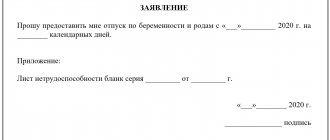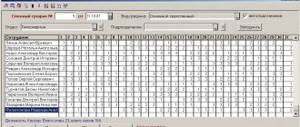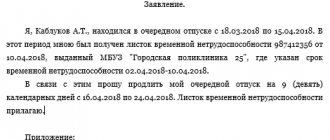10.06.2019
0
241
8 min.
Every Russian citizen has the right to paid vacation. It is enshrined in the Constitution, and the terms are determined by law. Today this is a vacation of 28 calendar days, annually provided to a specialist. In some situations, the base period is extended; a smaller number is unacceptable. Provision is carried out according to the organization’s schedule.
The legislative framework
Vacation issues are regulated by the Labor Code, which stipulates the obligation of management to send personnel on vacation every year. A transfer to the next year is allowed, but only by mutual agreement. A longer period, when an employee works without a break for 2 years or more, is prohibited. The wishes of the citizen himself are not taken into account. Even if he does not want to rest, the law obliges the employer to provide him with a vacation period.
Along with mandatory rest, there are additional holidays, also prescribed by law, they are divided into the following types:
- paid;
- unpaid.
The employer has no right to refuse to provide them. The basis for paid, additional leave is length of service, work in difficult and harmful conditions, situations where the employee has a disability, minor age, titles and benefits of a specialist. These grounds are also determined by the Labor Code.
Unused or incompletely used vacation
Partial holidays are calculated in the same way as in the previous example. Don't forget about maternity benefits:
- Men also have the right to take out maternity leave and, accordingly, payments.
- The duration of vacation is included in the length of service, as is going on maternity leave.
- The maternity period is taken into account when determining the total number of days off.
When calculating vacation days and compensation from the state and company, the accounting department uses a calculator to index transfers. Since pregnancy from the 30th week can become the basis for going on maternity leave, a person is obliged to take out additional leave to care for a child, that is, up to 3 years. If this is not done, then 36 months will be counted from the 30th week of pregnancy, and the employee may be called to work until the child is 1.5 years old.
Leave period
Annual paid leave is provided to all categories of employees, including those who work part-time, remotely and part-time. The basis is an agreement between the employee and the employer. In its absence, the employee cannot demand the required rest and protect his rights with the help of government bodies.
First vacation
The law establishes the employee’s right to rest after 6 months of work in the organization. The period remains unchanged at twenty-eight days. There is no question of any proportionality to the period worked in the company and management cannot appeal to it.
The parties can agree that the employee goes on vacation earlier than six months; this possibility is provided for by current legislation. It is interesting that relations are still regulated by provisions No. 169, established in 1930.
It is important to know that the countdown starts from the employee’s first day of work, regardless of whether it was a probationary period or full-time employment. If the accounting department or human resources department begins to count the days from the end of the test period, their actions can be challenged.
Subsequent holidays
After working for one year, employees go on vacation in any month, according to the schedule drawn up and approved by management. If their working period spans many years, they can request rest for the next year, given that in organizations this period is counted individually, without reference to the calendar.
In general, the law clearly sets out the rules only for the first leave. All subsequent procedures are carried out on a general basis, in accordance with the regulations of the organization.
Early care
Some categories of specialists have the right to request time off early. It applies only to the annual period, excluding additional days required by law. In particular, advance leave for 28 calendar days can be used by:
- pregnant employees, before going on maternity leave and immediately after it;
- minor workers;
- adoptive parents, provided that the children are under 3 months of age;
- persons working part-time. They have the right to take 2 jobs at the same time;
- men with pregnant spouses.
The listed categories are granted early leave both for the first time (before the expiration of 6 months from the start of activity in the organization), and in cases where the work has been carried out for a longer period.
Registration occurs through an application (if there is no schedule), its approval by management, and a corresponding order. Payments for a vacation period taken ahead of schedule are made as usual without additional charges. Marks are entered into the report card.
Vacation schedule and sequence
Every year, management draws up a schedule that is binding on the parties. After final approval, all changes to it are made only by agreement of the participants. Just like the right to 28 days of rest, the need for a schedule is determined by the Labor Code. According to it, the procedure is carried out no later than 2 weeks before the new year. Specifically, this date is December 17th, but in practice, most organizations compile the list much earlier.
As for the priority, it is indicated in the schedule, but the opinion of the trade union is taken into account. The employee may or may not agree to the proposed date by signing or not signing the document. Accordingly, the employer, for whom December 17 is a critical deadline, will be forced to compromise.
Advice! There is no need to write applications for vacation according to the schedule; it is enough to get the employee’s signature on the vacation notice. It is compiled in any form two weeks before planned care.
Beginning of the reporting period
Let us immediately give an example of how vacation days are calculated. Let's assume that a person got a job in March 2017, and took the first part of his vacation in August 2021. The reporting period for calculating vacation pay begins from the moment the employee is hired, and for 2021 he will be accrued days of rest, which are added to 2021. Vacation pay is calculated based on the days that a person worked without taking time off and periods at his own expense. The accountant calculates the average profit. It does not include:
- Time off is unpaid and not included in the rest period.
- Periods of absence of a person due to illness.
- Days when payment was not made according to regulatory and legislative frameworks.
These days are subtracted from the workers' paid days, and on their basis the amount of vacation pay is calculated, as is the amount of the vacation itself. It is worth noting that a highly paid job does not provide the opportunity to get longer rest due to the legal framework of the labor code. If part of the vacation is taken, as in the example above, then the second period of time off, although it relates to the current period, cannot be calculated based on income in the current year.
Duration of rest
The immediate rest period varies depending on the grounds. The law establishes a base period of 28 days, but this period increases for certain categories:
- civil servants;
- policemen:
- military;
- persons with disabilities.
The employer also has the right to independently extend the paid vacation of its employees, indicating this in the employment contract. For this purpose, the opinion of the trade union must be taken into account.
Minimum number established by law
All organizations operating in Russia are obliged to provide and pay employees vacation at the rate of 28 calendar days. More is possible, less is not possible. Profession, length of service, nature of work (full-time, shift, remote work) do not matter.
Rest is an inalienable right of the employee and the responsibility of the employer. Payment is made at the expense of the organization’s profit or budget funding, if we are talking about government agencies. Attempts to cancel vacation, payment or partial payment for a period are punishable by law and entail penalties.
Right to additional days
The company has the right to increase vacation time for its employees by prescribing additional days in its internal regulations. Subsequently, on this basis, a calculation is made, and the employee gets the opportunity to demand certain amounts and days, appealing to the labor agreement, collective agreement or work rules.
An employer can differentiate the rest period for employees depending on their position and profession. However, payment is made exclusively from the company's profits.
In parallel, the law defines a list of persons who are entitled to additional days, regardless of the internal regulations of the organization. These include:
- Minor workers. For them, vacation is 31 days.
- People with disabilities (any group) – 30 days.
- Teachers and lecturers – 42-56 days.
- Doctors of Science working in budgetary organizations - 48 days.
- Employees employed in the defense chemical industry – 30-40 days.
- Candidates of Sciences employed in budgetary organizations – 36 days.
- Health workers whose professional activities pose a risk of contracting AIDS – 36 days.
- Civil servants – from 30 days.
- Workers of the prosecutor's office and the investigative committee - 30 days, plus travel time there and back.
Additional days are also required to be given depending on territorial affiliation. This is 24 days for the regions of the Far North, 16 days for equivalent regions, 8 days for other northern regions.
Finally, the law grants the right to additional leave to people involved in hazardous and hazardous work, employees with special working conditions and irregular schedules. Extended days must be paid on a general basis.
Calculation of vacation days
The number of vacation days is counted from the moment the employment contract is concluded. To do this, a formula is used that takes into account the period of actual work, the employee’s justified absence (day off, planned vacation, holidays, sick leave, maternity leave), as well as vacation at one’s own expense (if any). This also includes the time when the employee was suspended from work based on the results of a medical examination, but it was not his fault.
It is important to know! If the employee’s activities were accompanied by illegal dismissal or suspension, this period is also included in the vacation calculation formula.
The concept of a billing period
The term pay period covers the year preceding the month in which the employee goes on vacation. The coefficient is calculated taking into account the total salary paid for the year and the average number of working days per month. April 2014 was marked by amendments, according to which the monthly average is 29.3 days.
The direct calculation formula includes the average daily earnings (salary for 12 months divided by 29.3), multiplied by the number of vacation days. In practice, nuances related to sick leave, business trips and other circumstances of the work of a particular employee are inevitable.
What is included in work experience?
Work experience is the period of a person’s working activity, as well as the time during which he did not work due to certain circumstances. The length of service is calculated when assigning pensions and social benefits. It includes the following periods:
- studying at a university;
- child care up to 1.5 years old, maximum number of 4 children or 6 years of experience;
- decree;
- a period of unemployment with the obligatory condition of registering with the employment center;
- service in law enforcement agencies and armed forces;
- caring for disabled people over 80 years of age;
- vacation and sick leave.
Calendar or working days
Rest is determined based on calendar days, not working days. For example, an employee leaves for three weeks starting on Monday. Returning to work is also carried out on Monday; weekends will be counted on a general basis, but payment for them will be in full.
Holidays
Exceptions include holidays, which extend the leave. Some of them are paid subject to inclusion in the official list of holidays of the Russian Federation. For example, if the vacation period falls on March 8, the employee will return to work 1-2 days later, depending on the number established for a particular year.
Duration of unpaid leave
In some situations, a citizen can write an application for unpaid leave.
The decision is made by the employer, who evaluates the validity of the reason and the necessity of the employee’s presence for the enterprise. During the process, he can propose his own term, indicating as many days as the organization is able to offer. There are categories of people who are entitled to unpaid leave by law. The employer has no right to refuse or offer a period shorter than that indicated in the application. These categories include:
- persons of retirement age – up to 14 days per year;
- WWII participants – up to 35 days a year;
- disabled people (of any group) – up to 60 days per year;
- family members of firefighters and law enforcement officers whose relative has died or been injured;
- parents of a newborn child, people planning to get married, employees who have experienced the loss of a close relative.
The situation when the employer initiates unpaid leave is considered separately. He does not have the right to do this, regardless of the explanations why he needs to send the employee on vacation. The latter can contact the Labor Inspectorate and the Prosecutor's Office. In this case, the fine for management reaches 50 thousand rubles.
Example of calculating vacation pay
For example, a person joined the company in August 2021 and did not take a vacation until March 2018, the duration of which is 14 days. But in August 2021 he went on vacation for 10 days at sea. The days were included “in the vacation account”, which is not reflected in the weekend balance as a full vacation used. How to calculate the number of vacation days in such a situation? You need to use a formula to calculate days off and average salary.
It follows from this that the person worked for 19 months and 14 days. According to the formula, you need to remove from these days 10 days that he has already taken off. It turns out:
- 19 months 14 days – 10 days = 19 months and 4 days.
- The length of service is 19 months, rounded up to an even number.
- For each year, 14 days of vacation pay are issued, which must be divided into 12 months a year.
- This number is multiplied by the period worked, which is the length of service - 19 months.
- It turns out that in less than two years a person is entitled to 22.16 days.
Using the same principle, you need to calculate the working period for each staff unit. If the time off falls on a non-working day, it cannot be counted, since it cannot be worked off. It should be paid according to the number of days of total staff employment. Also, the accountant is supposed to calculate the number of hours worked in advance in order to later draw up an estimate. This will make the job much easier when deducting the main days.
Individual situations
There are a number of nuances associated with the provision of leave, its use by the employee, termination at the initiative of the employer and compensation upon dismissal.
Splitting the period into parts
It is allowed to split the holiday into several parts, provided that one of them is at least 14 days. The remaining time can be divided as you like, at least 14 times. The only condition is to indicate this format in the schedule. If it is determined there that the employee is leaving for 28 days, and the decision to break up the vacation was made later, it will have to be agreed upon with management. He has the last word.
Conditions for recall from vacation
In the course of an enterprise's activities, situations often arise that urgently require the presence of an employee at the workplace.
The employer retains the right to recall a specialist, citing production necessity as the reason. In this case, the employee makes the decision to leave or not independently. Consent is drawn up in writing in any form; there is no standard established by the state. It invariably includes a heading, the word “order”, reason, instructions for accounting, date and signatures of the parties.
Attention! It is necessary to take into account that the vacation is 28 calendar days and no matter how much working time the organization requires from the employee, he cannot rest for less than 14 days at a time.
Some employees are prohibited from calling, regardless of the circumstances at the workplace. Categories include:
- pregnant women;
- minors;
- citizens employed in harmful and dangerous production.
It is also necessary that the head of the department where the called specialist works draws up a memo to management.
Extension and transfer of vacation period
If circumstances arise that prevent an employee from resting, his calendar leave is transferred to another time. The period is set by the manager, taking into account the employee’s own wishes. The legislation does not impose any specific requirements, with the exception of a time limit. So the transfer cannot be later than one working year from the date of granting the leave. The number of rest days is unchanged and transferred automatically.
Dismissal and vacation
At the end of the employment relationship with the employee, the company must compensate him for unused vacation days. The situation can also develop in the opposite way, when an employee does not return from vacation or rests in advance and then resigns. In this case, compensation is due to the employer. In all cases (especially when it comes to compensation to an employee), the accounting department is obliged to calculate the amount due to him and give it out during the final settlement.
Calculation of vacation pay for an unworked pay period
There are cases when employees do not use their legal calendar days off 100%, as they should. This is not a legal violation, but a completely standard situation. It’s completely possible not to take days off, not to go to the seaside, but simply work according to the plan with days off every week. But it happens that the company employs students, temporarily employed citizens, pensioners and mothers and fathers of many children. How are vacation days calculated in the following cases:
- A student goes to study in another city for a session.
- Pensioners receive invitations from relatives to visit sanatoriums.
- Parents are forced to go to the sea to improve their child’s health.
All this should be taken into account before counting officially used or unused vacation.
How are weekends different from holidays?
Weekends and holidays are not the same thing . There are holidays that are legally considered non-working days, that is, weekends. Their list is contained in Article 112 of the Labor Code of the Russian Federation:
- New Year holidays from January 1 to 6 and 8;
- Christmas - January 7;
- February 23;
- March 8;
- May 1 and 9 are Labor Day and Victory Day, respectively;
- Russia Day - June 12;
- November 4 is National Unity Day.
Sometimes these days fall on Saturday and Sunday, then the day off is usually transferred to the first working day after the holiday. More complex combinations are also possible with shifting the working day to a weekend to get a longer uninterrupted rest.
Rest is always a holiday, but from the point of view of the law it is not always the same thing
A day off, unlike a holiday, is simply a day of continuous rest between working days. This is also stated in the Labor Code of the Russian Federation (Article 111). With a five-day working week there are two, with a six-day week - one. Usually this is Saturday and Sunday. If the work requires a flexible schedule, these may be other days of the week. Exactly when employees will have days off is specified in the employment contract and internal labor regulations.
Formulas for calculating vacation pay and days off
The number of vacation days for each type of schedule is calculated using the same formula. To begin with, a period of days is established that the employee is entitled to, taking into account study leave, holiday weekends and other time off. The entire period by day must be multiplied by the amount of payments due, which will allow the employee’s daily income to be determined. SDZ = Salary/Drab. The last indicator is the days worked for the period for which money is accrued.
Important! It is necessary to take into account not only the actual cost of a working day, but also payments for lunches, travel passes, payment for food stamps, travel expenses and more. Social benefits that are accrued to the employee as an insurance premium are not subject to accounting.
- The reporting period is the time that the employee worked, even if it was several weeks.
- Next, Drab is installed. According to the formula, it turns out: 12 months multiplied by the average length of the calendar period, which turns out, for example, 12 * 28.9 days per month.
- Since people don't always work seven days a week, you need to find out how many breaks he might have had. Drab. = Dp. + Days, where Days means days from the used period, Days means days from unused rest.
Having found out the average amount of vacation, you can set O - vacation pay. You need to multiply SDZ by vacation days. If the vacation falls on an increased number of calendar days, all payments must be taken into account. In the case of maternity leave, a separate limit for the days used is also established, but they have a separate rate, since a separate planned calendar budget is calculated for this period. It may not exist if a woman or man receives benefits from the state.
Number of days of vacation per month of work
To determine the number of rest days that accumulate per month, it is worth using one of the developed methods. Its meaning is simple - 2.33 days are accrued per month of activity, they fall on the annual vacation provided. The indicator is calculated as follows:
28 days:12 months = 2.22 days.
According to calculations using the method described above, the number of vacation days, based on the number of months worked, has the following values:
- 1 month – 2.33;
- 2 – 4,66;
- 3 – 6,99;
- 4 – 9,32;
- 5 – 11,65;
- 6 – 13,98;
- 7 – 16,31;
- 8 – 18,64;
- 9 – 20,97;
- 10 – 28;
- 11 – 28;
- 12 – 28.
This method of calculation is easy to use, and it was recognized by Resolution No. 169 of the People's Commissariat of Labor of the USSR in 1930.
Vacation after leaving maternity leave
Here's how vacation is calculated after leaving maternity leave:
Maternity leave to care for a child up to 3 years old for employee Ivanova L.D. began after the sick leave issued to her for pregnancy. It ended on 02/02/2018. The sick leave has been open since November 21, 2014. After returning from maternity leave, Ivanova turned to management with a request to grant her leave (annual, paid). By law, in accordance with local regulations of the enterprise where Ivanova works, she is entitled to a vacation of 28 days. The calculation period takes the time interval from November 21, 2014 to February 2, 2018.
The first thing you need to do in order to correctly calculate her vacation pay is to determine the amount of income received for 12 months. The following formula is used for this:
Average earnings = income / number of full days X 29.3 + number of days in partial months
Presumably, in this example, the amount of total income for the specified period of time was 50,000 rubles. After this, the average earnings (daily) are determined. It should also be calculated using the formula: SDZ is equal to 50,000 / 12 months / 29.3. The result is 1,422 rubles. After this, the final action in this calculation is drawn up, namely determining the amount of vacation money. For this, vacation pay = 1,422 X 28 = 39,816 rubles. From this amount it is necessary to withhold 13%, personal income tax. Give the difference to employee Ivanova.
The formula applies to insured persons who are officially employed by the company.











